Carnegie Learning Algebra II Student Skills Practice 1st Edition Chapter 1 Exercise 1.2 Skills Practice
Page 241 Problem 1 Answer
Given designs. The aim is to find the expression.
For design 1 there are 2 shaded parts.
For design 2 there are 3 shaded parts.
For design n there are n+1 shaded parts.
Therefore, the expression is n+1.
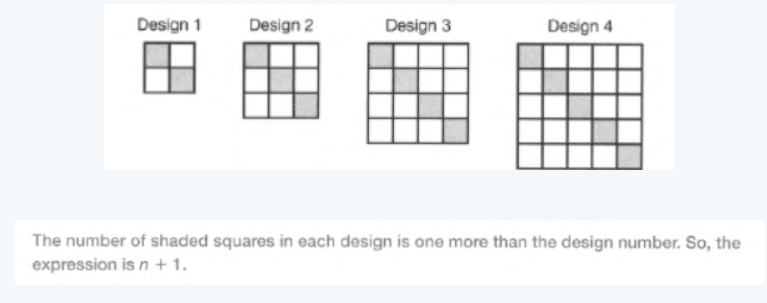
Page 241 Problem 2 Answer
Given the pattern.
The aim is to find the expression.
For first step is 3.
For second step is 32.
For nth step is 3n.
The expression is 3n.
Carnegie Learning Algebra Ii Chapter 1 Exercise 1.2 Solutions
Carnegie Learning Algebra II Student Skills Practice 1st Edition Chapter 1 Exercise 1.2 Skills Practice Page 241 Problem 3 Answer
Given: Charlie watches as a pattern develops. He starts with 3 guppy fish in his fish tank.
The next month, he finds 6 guppy fish in his tank. The following month, he finds 11 guppy fish in his fish tank.
To find: Write an expression to model the pattern of guppy fish in Charlie’s fish tank. Show your work.
The nth rule is quadratic ⇒ an2+bn+c, where a+b+c=1term
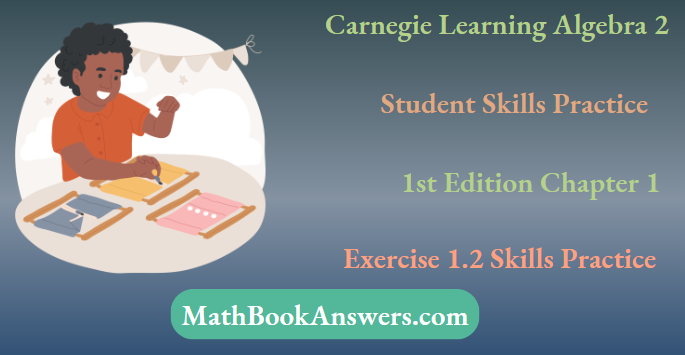
3a – b = the first difference 2a = the constant difference between each two difference
∵ The first term is 3 ∴ a+b+c=3
∵ The first difference is 6−3=3
∴ 3a−b=3
∵ 6−3=3 and 11−6=5∵5−3=2
∴ The constant difference is 2
∴ 2a=2
⇒ divide both sides by 2
∴ a=1,
3a−b=3
∴ 3(1) – b = 3
∴ 3−b=3
⇒ subtract 3 from both sides
∴ b = 0
∵ a+b+c=3
∴ 1+0+c=3
∴ 1+c=3
⇒ subtract 1 from both sides
∴ c=2
∵ The nth rule is ⇒ an2
+bn+c , where n is the position of the number
∴ The nth rule =1n2+0n+2
∴ The nth rule = n2+2
Therefore, the expression of the pattern is n2+2.
Page 242 Problem 4 Answer
The download function (f(t),inkb) , expressed as a function of time (t, in minutes) is a quadratic function. Let f(t)=at2+bt+c, where a,b,c are arbitrary real numbers.

When t=1, we have f(t)=1 so that a+b+c=1.
When t=2, f(t)=7 so that 4a+2b+c=7.
When t=3,f(t)=17 so that 9a+3b+c=17.
When t=4, f(t)=31 so that 16a+4b+c=31.
The augmented matrix of the above linear system is A (say) =

To solve the above linear system, we have to reduce A to its RREf which is
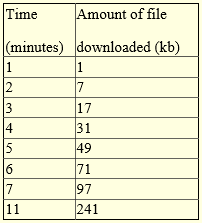
This implies that a=2,b=0 and c=−1.
Thus, f(t)=2t2−1
The required table, duly filled up , is attached:
The scatter plot is,
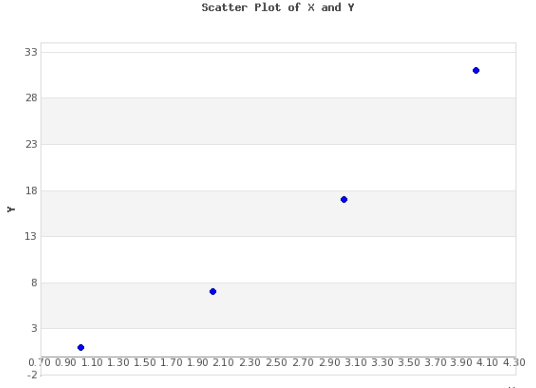
Carnegie Learning Algebra II Student Skills Practice 1st Edition Chapter 1 Exercise 1.2 Skills Practice Page 242 Problem 5 Answer
Given the table.
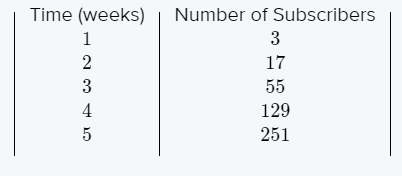
The aim is to find the x.
Using the table,
The nth terms is,
Tn=a+(n−1)d
Tn=9+(n−1)6
Tn=3+6n
The nth number of books is,
x=(x−3−6n)−(6n−3)/3+6n.
Page 242 Problem 6 Answer
Given that the table.
The aim is to find y.
The nth term is,
Tn=3+n−1/2(2a+(n−1−1)d]
Tn=3+n−1/2(2(6)+(n−2)4)
Tn=3+(n−1)(6+2n−4)
Tn=3+2n2−2
Tn=2n2+1
Therefore, y=2n2+1.is the required answer
Skills Practice Exercise 1.2 Answers
Carnegie Learning Algebra II Student Skills Practice 1st Edition Chapter 1 Exercise 1.2 Skills Practice Page 243 Problem 7 Answer
Given the expression 6n+8,2(3n+4).
The aim is to show that 6n+8=2(3n+4).
By distributive law,
2(3n+4)=2(3n)+2(4)
2(3n+4)=6n+8
Therefore, 6n+8=2(3n+4).
Page 243 Problem 8 Answer
Given that n2+4n−n2 and 4n.
The aim is to show that (n2+4n)−n2=4n.
Use the commutative law,
(n2+4n)−n2=n2+4n−n2
(n2+4n)−n2=n2−n2+4n
(n2+4n)−n2
=4n
Therefore, (n2+4n)−n2=4n.
Page 243 Problem 9 Answer
Given that 3x+5,2(x+3).
The aim is to find whether both are equivalent or not.
Use the distributive law,
2(x+3)=2(x)+2(3)
2(x+3)=2x+6
Which is not equal to 3x+5.
Therefore, both are not equivalent.
Carnegie Learning Algebra II Student Skills Practice 1st Edition Chapter 1 Exercise 1.2 Skills Practice Page 243 Problem 10 Answer
Given that 15−6x,15(1−6x).
The aim is to determine both are equivalent.
Use the distributive law,
15(1−6x)=15(1)−15(6x)
15(1−6x)=15−90x
Which is not equal to 15−6x.
Therefore, both are not equivalent.
Page 243 Problem 11 Answer
Given that (y+y+2+y)+3y and 6y+2.
The aim is to determine the equivalence relation.
Use the law,
(y+y+2+y)+3y=(2y+2+y)+3y
(y+y+2+y)+3y=(3y+2)+3y
(y+y+2+y)+3y=3y+3y+2
(y+y+2+y)+3y=6y+2
Therefore, both are equivalent.
Algebra Ii Chapter 1 Skills Practice Solutions Exercise 1.2
Page 243 Problem 12 Answer
Given that 8y−3+10y,3(6y−1).
The aim is to determine the equation.
Use the distributive law,
3(6y−1)=3(6y)+3(−1)
3(6y−1)=18y−3
And, 8y−3+10y=8y+10y−3
9y−3+10y=18y−3
Therefore, 3(6y−1)=8y−3+10y.
Carnegie Learning Algebra II Student Skills Practice 1st Edition Chapter 1 Exercise 1.2 Skills Practice Page 244 Problem 13 Answer
Given: A table lists the number of people who attended a museum (in thousands) over the course of several months.
We have to represent each pattern as an expression and as a graph. Then identify whether the pattern is linear, exponential, or quadratic.
The number of people who attended the museum is four times the number of months plus 7.
Hence, an expression to represent the pattern is 4x+7.
since the power of the variable x is 1.
The pattern is linear.
The graph is plotted as shown.
The expression is 4x+7. We can say from the graph that the expression is linear.
Page 244 Problem 14 Answer
Given: A local pet shelter is able to see many of their pets adopted. The table lists the number of pets that have been adopted over several weeks.
To find: We have to represent each pattern as an expression and as a graph. Then identify whether the pattern is linear, exponential, or quadratic.
Let n be the number of weeks.
Then we can write the expression as n2+7
The graph will be

This expression is quadratic.
There is a square in the equation, therefore it is quadratic.
Carnegie Learning Skills Practice Exercise 1.2 Explained
Carnegie Learning Algebra II Student Skills Practice 1st Edition Chapter 1 Exercise 1.2 Skills Practice Page 245 Problem 15 Answer
Given: Emilio is looking at bunches of grapes at the market. He starts to notice a pattern in the number of grapes in each bunch.
To find: Write an expression for the number of grapes in each bunch.
Let n be the number of bunch.
The expression for the number of grapes in each bunch.
5 grapes=12+5
14 grapes=22+10
24 grapes=32+15
36 grapes=42+20
The general expression for the number of grapes in each bunch is n2+5n.
Page 245 Problem 16 Answer
Given: Nolan takes a photo of a parking lot every two hours. He counts the number of cars in each photo. The number of cars increases in each photo.
To find: Write an expression for the number of cars in the parking lot.
Let n be number of two-hour intervals.
1 car,n=1→13→1
8 cars, n=2→23→8
27 cars, n=3→33→27
64 cars, n=4→43→64
Hence the general expression for the number of cars in the parking lot is n3.
Carnegie Learning Algebra II Student Skills Practice 1st Edition Chapter 1 Exercise 1.2 Skills Practice Page 246 Problem 17 Answer
Given: A store had a grand opening sale. During the sale, each person entering the store received a coupon for 10% off their entire purchase.
The table lists the number of people who received a coupon.
To find:We have to represent each pattern as an expression and as a graph. Then identify whether the pattern is linear, exponential, or quadratic.
Let n be the number of hours open.
Then we can write the expression as 3n2.
The graph will be
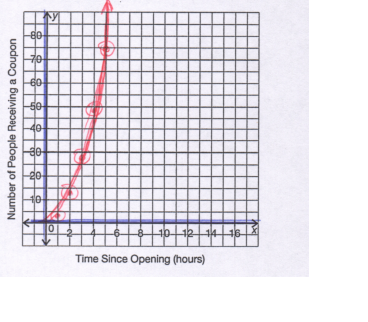
Chapter 1 Exercise 1.2 Skills Practice Guide
This expression is quadratic.
There is a square in the expression, hence it is a quadratic expression.
